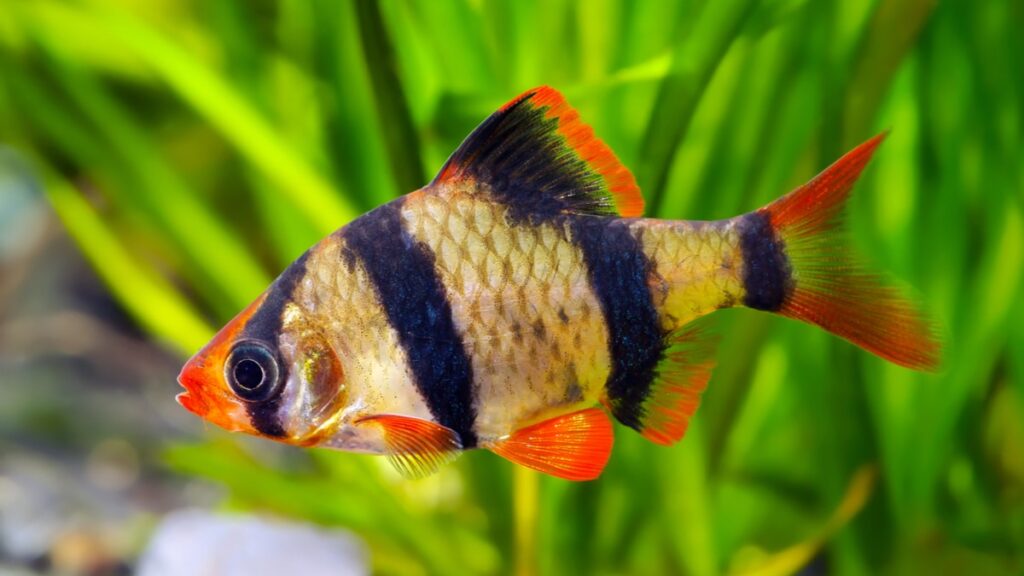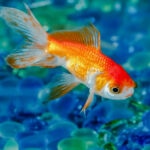Keeping and Breeding Tiger Barbs

Photo by Grigorev Mikhail
Watching tiger barbs (Puntius tetrazona) reminds me of throwing a handful of super balls into an empty swimming pool. The resulting chaotic activity and seemingly endless motion are characteristic of this hyperactive species.
Tiger barbs, also called Sumatra barbs in some parts of the world, originate from Indonesia, Malaysia and Brunei. They are found in streams and tributaries of rivers, such as the Kampar and Musi, and were originally identified 1855 by Pieter Bleeker, a Dutch medical doctor performing duties in Indonesia.
Tiger barbs have been identified by various scientific names, depending upon the era of the reference material. Older publications usually refer to them as Capotea tetrazona, C. sumatraus or Barbus tetrazona. In the early 1990s, the name was updated to Puntius tetrazona — the longevity of this recent classification is tenuous because ichthyologists are constantly refining species identifications. The latin name Puntius tetrazona derives from Latin (probably a pseudo-Latin biologist invention), though some sources claim Puntius is derived from Greek, and others state it is a regional term from where they are found. In Latin, tetra is “four” and zona is “belt” or “girdle.”
The tiger barb is a strikingly beautiful tropical fish. Its arrowhead-shaped body — glowing as if gilded — is encircled by four black vertical stripes. The common name “tiger barb” comes from its resemblance to the famous Sumatran tiger.
The tiger barb, with its large cycloid scales, does not have a distinguishable lateral line. Brilliant orange coloration covers the mouth, nares (nostrils) and the trailing edge of the dorsal (top) fin. The caudal (tail) fin is highlighted with vivid orange markings on the top and bottom, making the colorless midsection almost invisible. The pectoral (side) fins, pelvic (under) fins and anal fin are also adorned with orange coloration.
All of these distinguishing features identify the tiger barb as one of the most beautiful of aquarium fish. In an aquarium, tiger barbs will easily grow to 2 inches. There are reports of some reaching up to 3 inches in length. The males typically are smaller and often more colorful than the females. The females are distinguished by a fuller outline and usually slightly softer color in the mouth and nares region. Having kept tiger barbs for many years, I can confirm the coloration differences. Interestingly, my current mated pair is equally colorful. The only distinguishing characteristic is the male’s smaller and slimmer body, and in typical male fashion, he is the suitor. Sexing is difficult, so acquiring at least six is advised in order to increase the probability of attaining a mated pair.
Tiger Barb Tank Needs
I recently observed a clerk in a big box store selling a customer four tiger barbs, two angelfish and six neon tetras, all to be housed in the customer’s 10-gallon tank. The results are quite predictable. From a tiger barb’s perspective, there are two types of fish: tiger barbs and targets. Slow-moving tankmates are treated like high-speed slalom buoys, and long-finned tankmates are perfect for fin-nipping; so, I’m sure the tiger barbs nipped the fins of the other fish and terrorized the tank. First, when there aren’t enough tiger barbs to disperse their social heirarchical aggressions, they take it out on other tankmates, and second, it’s analogous to taking a bunch of pre-school-age children to a senior citizen’s birthday party in a small room with a big cake. Tiger barbs are like active children, and if given the proper conditions, are simply wonderful.
These fish need a tank with an abundance of swimming space. Long tanks, such as a 20-gallon long or a standard 55 are ideal for providing extended swimming room. They will quarrel among themselves if crowded, and if housed with non-compatible fish, they can be tremendous pests. I’ve kept tiger barbs for many years, and found they are perfectly fine tankmates for other fast-moving, short-finned fish, such as zebra danios (Danio rerio). (Do not house them with the long-finned zebra danios, though.)
I prefer to keep tiger barbs in a species tank rather than a community setup. A low bioload is highly recommended because tiger barbs seem to not pester each other as much when given space.
For my most recent setup, I selected a 20-gallon-long mirror-back tank to house a mated pair of tiger barbs. This is an ideal tank because it affords plenty of horizontal swimming room for these fast-moving, playful fish. Tiger barbs are mid-level dwellers, so depth is not important to them. This tank is also ideal for plants because the shallow water allows maximum light penetration. The aquarium has a 2-inch-deep river sand substrate and is lightly planted with corkscrew val (Vallisneria spiralis) and Sagittaria subulata. Water sprite (Ceratopteris thalictroides) is used as a “nest” for breeding.
The tank’s water level is up to the filter’s weir (water return ramp). Filling the tank to the weir allows filtered water to gently return to the tank and quietly flow across the surface. This technique significantly reduces surface turbulence that contributes to a loss of carbon dioxide (which plants need for growth). The ambient temperature of my basement fish room is 69 degrees Fahrenheit, so I use a 200-watt heater to maintain a steady aquarium temperature of 79.5 degrees. Lighting consists of one 40-watt, full-spectrum fluorescent strip light and one 150-watt incandescent plant light positioned far enough away from the tank to avoid excessive heat transfer.
I use tap water that is only treated for chlorine removal. My tap water readings are pH 7.2, alkalinity (KH) 80 ppm, total hardness (GH) 75 ppm, and unfortunately, a moderately high nitrate level (NO3) of 20 ppm. The fish and plants do fine in these water conditions. In fact, the plants are displaying significant growth.
I feed my tiger barbs mostly frozen or live foods, supplemented occasionally with flake fish food. Live Daphnia, mosquito larvae, microworms, brine shrimp, frozen bloodworms and Mysis shrimp are always on the menu. They will eat food from the surface as well as from the bottom, but clearly they prefer mid-level feeding where they swim. Tiger barbs never become full and will ravenously eat as long as food is provided. Be cautious not to overfeed them, which could result in foul water and ill fish.
Breeding Tiger Barbs
Tiger barbs are easy to breed and make an excellent choice for a hobbyist’s third-level breeding experience. I always recommend new hobbyists learn fish breeding with livebearers, such as guppies (level one), later transitioning to egglayers with something almost as easy (level two), such as zebra danios. Unlike levels one and two, where you just put them together, and zing, they reproduce, tiger barbs require a little more effort and planning.
If your goal is breeding, purchase at least six and quarantine them in a 30-gallon tiger barb species tank. At the fish store, don’t be rushed into accepting any fish the clerk catches. Examine each one for coloration, and make sure the fins are not damaged. Upon release into the quarantine tank, the dominant ones will quickly establish a rank order. I have no evidence to support which sex the most dominant fish will turn out to be. The most aggressive one is often male, but it’s just as likely to be female.
Eventually, you will notice that at least two seem to be interested in each other. The one showing the most interest is most likely the male, which is probably smaller in size. If you have several smaller ones showing interest in a larger one, select the best of the slimmer and more colorful fish showing interest. The female will almost always be duller in color and have a more plump figure than the male. Place both fish into a 20-gallon-long breeding tank. The tiger barbs not selected for breeding should be returned to the store, or even better, donated to a local school.
The mated pair should be fed soon after introduction into the breeding tank. Feed them something like brine shrimp in quantities that ensure there will be plenty for each fish to eat in a noncompetitive manner. Following a day of acclimation, install a tank divider (widthwise) that divides the length of the tank in half. I use a piece of Plexiglas drilled with many holes (smaller than the tiger barbs), which allows sufficient water circulation but denies the fish access to each other. Do 10-percent water changes daily for five days, then remove the divider. The pair will eagerly seek one another. I mentioned that I use water sprite as a spawning site. They will make a beeline to this bushy plant, where the male will push up against the female and follow behind releasing sperm while she indiscriminately deposits her eggs.
Tiger barbs are lousy parents. They eat their eggs, sometimes even during the spawning process, so removing the eggs or parents is essential for fry survival. Honestly, I don’t know how these fish survive in the wild while having such a voracious appetite for their young.
I like to remove the eggs from the breeding aquarium because the eggs are easier to take care of in a small, easy-to-clean, bare-bottom tank. One method of removing the eggs is simply scooping them out with a plastic cup. With one hand, gently move the cup to the spawning area. Use the other hand to slowly guide the eggs and water sprite into the cup. You will be able to capture a significant number of the eggs using this method.
In the fry tank, use well-seasoned sponge fish tank filters rated for a much larger aquarium. For example, a 10-gallon fry tank should have a sponge filter rated for at least 30 gallons. I sometimes use two sponge filters, depending on the number of eggs. Maintain a temperature similar to the breeding tank, and the eggs will hatch in about three or four days. When their yolk sacs are used up, feed the fry small amounts of infusoria, Daphnia and brine shrimp three times a day. Start them off on smaller foods, such as infusoria, and after they have grown enough to take large foods, feed them brine shrimp. Feed only what they can eat in a few minutes.
Water sprite and a few added sprigs of Java fern (Microsorium pteropus) will provide some refuge for the fry and give them something to peck at. Partial water changes are essential, with 10 percent being changed at least every other day. Just as you would do for a regular aquarium, test the water. I recommend a daily test for ammonia, nitrite and nitrate. Be especially watchful for ammonia spikes. At about the two-week mark, move the fry to a larger aquarium and start calling pet stores to see if they will purchase them in about 70 days. Don’t expect to get rich selling your tiger barbs. Your reward will be the immense satisfaction knowing you are successfully breeding a truly gorgeous tropical fish.
If your goal is to maintain a tiger barb show tank rather than breeding, envision the following: a 55-gallon tank with a black background, black gravel and tall plants slowly swaying in the gentle current. Use a full-length fluorescent strip light on the glass covering the tank and suspend two small spotlights a few inches above the glass. The lighting will enhance the coloration of the fish, making them sparkle as they playfully swim about the tank. Use fish tank decorations like driftwood and some large, multi-hued rocks. Incrementally introduce six barbs each week for a four-week period, ending up with about 24 in the tank. This will definitely not be a sedate tank with its nonstop action, but it will certainly be a stunning and beautiful species fish aquarium.
Tiger barbs are an easy-to-keep, entertaining species. With spacious living conditions and careful selection of tankmates, they are an ideal choice for both community and species tanks. Enjoy!



